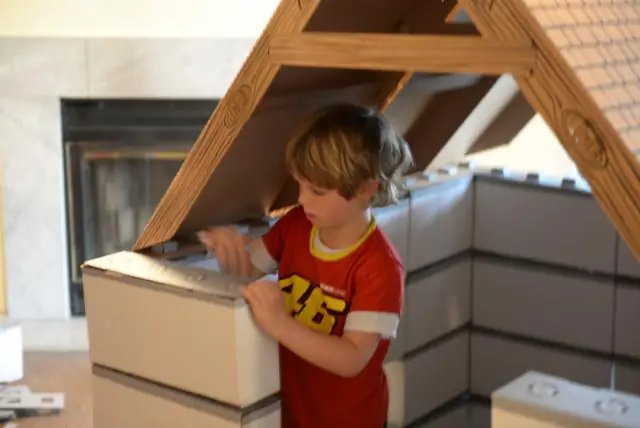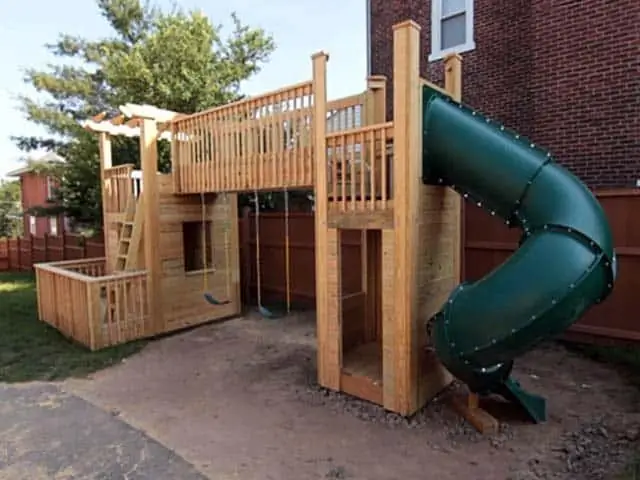
Table of contents:
- How and from what to build a frame shed with your own hands
- What is a frame shed for?
- The advantages of the frame structure
- Preparation for construction, design and calculations
- Calculation of the need for materials
- Step-by-step instructions for building a frame shed
- Frame device
- Calculation of the need for insulation materials
- Video: building a shed with a pitched roof yourself
- Author Bailey Albertson [email protected].
- Public 2024-01-17 22:26.
- Last modified 2025-06-01 07:32.
How and from what to build a frame shed with your own hands

A shed on a suburban area is vital. Otherwise, you will have to store garden tools and equipment in the house itself. Naturally, this will not contribute to a comfortable stay. A barn is a simple lightweight construction. Making it yourself is quite possible for most skilled men.
Content
- 1 What is a frame shed for?
- 2 Advantages of the frame structure
-
3 Preparation for construction, design and calculations
3.1 Preparing the installation site of the shed
-
4 Calculation of material requirements
- 4.1 Table: example of calculating materials for building a barn
-
4.2 Tools for building a barn
4.2.1 Table: Tool for Building a Barn
-
5 Step by step instructions for building a frame shed
- 5.1 How to make a foundation
- 5.2 Photo gallery: types of lightweight foundations for lightweight buildings
-
6 Frame structure
- 6.1 Video: building a metal frame for a barn
- 6.2 Floor and wall cladding
-
7 Calculation of the need for insulation materials
- 7.1 How much expanded clay is needed
-
7.2 How much plate or roll insulation is needed
7.2.1 Photo Gallery: Shed Finishing Work
- 8 Video: building a shed with a pitched roof yourself
What is a frame shed for?
An outbuilding in the form of a barn on a suburban area is vital. It is intended for storing garden and garden tools, ranging from a simple shovel or hoe and ending with a walk-behind tractor, a watering pump and other expensive equipment. In addition, it is simply not safe to store pesticides, fertilizers or a small supply of gasoline in other premises.

Thanks to the frame shed, it will be possible to store all garden tools
The advantages of the frame structure
The main advantage of the frame structure is its fast erection and low labor intensity of construction. The advantages are as follows:
- The possibility of using sawn timber of the second or third grade.
- Ease of design.
- The ability to quickly move to another place, if provided for by the structure of the building. To do this, the support frame is made with a small projection and a notch at an angle of 45 degrees, forming a kind of runners.
- Fast erection.
If we talk about the shortcomings of structures of this kind, then they arise only in connection with design or execution errors.

A frame shed is built quickly and easily
Preparation for construction, design and calculations
Preparation for the construction of a barn consists of the following activities:
- Determination of the location. Since this structure is intended to store items and materials needed for use in the garden, the shed must be placed in an area adjacent to the front garden. To save space, it is better to build it closer to the boundary. The rules stipulate that the shed should not be closer than one meter to the neighboring site.
- It is better to choose the dimensions of the building in terms of the rational use of materials. So, the best option would be 6x4 meters. At the same time, the length corresponds to the dimensions of the standard length of sawn timber - 6 meters, and the width assumes a two-meter-long offset, which can be used for racks on the low (back) side of the building. For the front, you can cut the bar in half and take it on the racks completely.
- Thus, the main dimensions of a shed with a lean-to roof were determined, the angle of inclination of which will be about 14 degrees. This is an ideal building option in terms of the rational use of materials.
- The distance between the frame posts should be no more than one and a half meters. Jibs must be installed at the extreme openings to resist wind loads. The size of the timber for them must be the same as the size of the bearing support legs. If a beam of 100x100 millimeters is used, then the jibs can be made from a beam of 50x100. A total of such parts will need 8 pieces.
- The upper frame strapping must be made of a bar of the same size as the lower one, in our case it is 100x100 mm.
- For rafters, you can use a beam of 50x150 mm, installed vertically in width.
- The outside wall cladding should be made of any waterproof sheet material: plywood, OSB boards, drywall. A common material for walls is unedged board. Before installation, the tes must be sanded.
Let's deal with the supporting structure. The barn does not need a massive foundation. It can be installed on small concrete blocks by using them in the corners and in the middle of the walls. However, in areas with increased wind loads, it is better to use screw anchors. This is a miniature version of the screw pile. It is enough to install them at a distance of two meters from each other, the total need for such parts will be 8 pieces.

If you use the scheme of the frame device, you can make a solid shed with your own hands
Shed installation site preparation
The site for this structure is prepared as follows:
- It is necessary to free up space from the fertile layer, which will require soil removal to a depth of 30 centimeters. Carefully level and tamp the surface.
- After that, it is necessary to arrange a drainage layer by pouring sand 12-15 centimeters thick into the depression. Fill the rest with gravel of medium fraction, compact the entire surface.
This reduces the likelihood of stagnant water under the barn, which will easily drain through the drain.
Calculation of the need for materials
The amount of materials needed to build a barn is convenient to calculate in tabular form.
Table: an example of calculating materials for building a barn
| Name | Appointment | Quantity (pcs) | Size (cm) | Standard data (pcs / m3) | Notes |
| Anchor | Support structure | 6 | |||
|
Pine beam 100x100 Total by type of material: |
Bottom harness in length Bottom harness in width Upper harness in length Upper harness in width Rear post Rear post Front post Doorway |
2 11 |
600 400 600 400 200 200 300 90x 200 600 |
16.6 |
From segments From segment Total requirement 0.7 cubic meters |
|
Beam 100x50 Total by type of material: |
Additional lathing in the openings of the Ukosina Window openings 60x20 cm |
24 11 |
150 300 160 600 |
33 | Total requirement 0.33 cubic meters |
|
Unedged board Total by type of material: |
Outside cladding overlapping the rear wall Same for the front wall Same for the side walls |
48 48 32 56 |
200 300 300 600 |
28 | Total requirement 2.0 cubic meters |
| Beam 50x150 mm | Translations | 7 | 400 | 22 |
Remaining 7 pieces x200 mm Total requirement 0.33 cubic meters |
In addition to the above, you will need a plastic wrap for a moisture protection device. With a width of three meters, it needs 20 running meters for the outer protective layer and the same for the inner one. Depending on the price indicators, it can be replaced with roofing material.
The finishing coating of the roof is taken for the simplest of financial reasons. Ordinary slate or fiberglass, galvanized or painted corrugated board will do. When calculating the need, you need to take into account overhangs with a width of 0.3-0.5 meters.
It is better to make the interior decoration from sheet material. Leftovers from home decoration will also come in handy.
Thermal insulation in an unheated barn room has the opposite meaning. In hot weather, it is important to keep the temperature from overheating in the sun. In such a situation, it will be very uncomfortable to be in it without thermal insulation. It is also important to perform high-quality waterproofing of the walls.

A frame shed can also be built on poles
Barn building tools
For such a simple structure, the need for a tool is small.
Table: tool for building a barn
| Tool name | Operations performed |
| Shovels bayonet and shovel | Clearing the construction site, arranging the drainage layer |
| Scrap | Screwing anchors into the ground |
| Welding machine | Installation of heads on anchors |
| Saw-hacksaw for wood | Cutting sawn timber, washed down connections |
| Construction level, plumb | Installation of mounting elements |
| A hammer | Installing fasteners |
| Screwdriver | Fastening the fasteners with screws |
Step-by-step instructions for building a frame shed
To build a barn, you need to perform a number of sequential steps:
How to make a foundation
You don't need a strong foundation to build a barn. It is often installed simply on brick stands. This directly depends on the nature of the soil at the location. If the subsoil layer consists of clay or heavy loam, this threatens with significant ground movements, as a result of which the structure can be skewed with damage to the walls and jamming of doors. In such a situation, a fairly deep foundation is needed, the supporting part of which will be below the level of soil freezing.
These conditions are met by the following types of support bases:
- Pile-screw. Screw piles are screwed into the ground to the required depth, their upper ends must be aligned horizontally along the stretched cord. Then heads are installed on them for attaching the support bar. In addition to the quality of the soil, this choice can be made when building a shed on a slope.
- Columnar. For the device, you need to dig (or drill) pits below the freezing level of the soil. At the bottom, make a drainage of sand (12-15 centimeters) and gravel in approximately the same layer, tamp the backfill. Reinforcement is made with a frame made of steel bars in the amount of 4-6 pieces vertically, fastened with crossbars. The armoring must be assembled on the surface and immersed in a pit. Install the formwork of the required height on top of the ground. Pour concrete into the ground. After seven days, the formwork can be removed and work can continue.
It makes no sense to consider other foundation designs. They are heavier and more expensive in terms of execution: tape, grillage and other types of support bases, and they are inappropriate for a structure weighing several hundred kilograms.
Photo gallery: types of lightweight foundations for lightweight buildings
-

Shed foundation - Column foundation with concrete grillage serves as a reliable support
-

Bored foundation - The lightweight foundation on piles will withstand loads on unfavorable soils
-

Pile-screw foundation - Pile-screw foundation with a wooden grillage for installing a barn does not require earthwork
-

Strip foundation - Strip foundation - a lightweight option for installing a lightweight structure
Frame device
The base for the shed is ready for further installation when a timber strapping is installed and fixed over the supports. It should represent a regular rectangle, the diagonals of which are equal to each other. Checking is done by measuring with a long tape measure or cord.
Assembling the frame:
- Installation of a log for the floor. A bar of 50x150 mm is used. The distance between the lags should be 75 cm. Each of them cuts into the strapping beam to a depth of 50 mm. A corresponding inset is also made. You need to fasten it with a nail in the middle and two corners to the body of the strapping beam.
- Installation of corner posts. Racks with a height of three meters are installed on the front wall, two meters high on the back. The distance between them is 1.5 meters. Corner posts are placed vertically with plumb line control. They need to be fixed with temporary jibs, check the verticality again and fasten them to the harness with two corners and two flat plates each. Fastening is done with self-tapping screws.
- A cord is pulled between the corner posts and the rest are installed at a specified distance along it. Fastening is done with corners and plates.
- Installation of the upper strapping made of 100x100 mm timber. For inclined beams, supports are cut with the required slope.
- Installation of transfers for roofing made of 50x150 mm timber. An inset is made on the support beams when joining parts. The transfers are fastened with screws or M12 studs with wide washers, two screws per joint.
- Fastening jibs. They need to be placed from the top of the corner posts to the bottom harness. The material for them is a bar of 50x100 mm. Fastening is done with self-tapping screws.
- Lathing on the walls. It is made of 50x100 mm bar. Parts are placed in the openings formed by the racks at a distance of one meter from each other parallel to the straps. Fastening is done using flat plates with self-tapping screws.
As an option, you can consider making a shed frame from a profile pipe measuring 60x60x3 mm. The dimensions of the building are the same, the distance from the base of the lower harness to the top should be two meters.

The profile pipe for the frame will ensure long-term operation of the shed
The work is performed in the following order:
- Preparation of parts: racks and battens. Metal cutting is done with a grinder. In addition to pipe parts, you need to prepare metal corners that are installed at each pipe connection. The size of a triangular piece made of steel with a thickness of 3 mm is 200x200 mm.
- The frame is welded by electric welding with angle control. The face welds are cleaned and the reinforcement removed.
- Before further assembly, the metal frame is treated with a primer, then coated with paint for metal.
- With a metal base, sheet materials are used for wall cladding: flat slate, fiberglass, OSB boards or moisture-resistant plywood.
- Moisture protection in this version is necessary. The film is pre-fixed with construction tape.
- Translations and logs are made from the same timber as with a wooden frame.
Video: building a metal frame for a barn
Floor and wall cladding
Further work on a wooden or steel frame is done in almost the same way:
-
Wall covering. It can be done with various sheet materials. For economic reasons, we will choose an unedged board. Before filling the boards on the racks and crate, it is necessary to install a moisture protection made of polyethylene film 200 microns thick or roofing material. You can fix it with a construction stapler on metal brackets.

Facing the walls of the barn with boards Unedged boards are perfect for decorating the walls of the barn.
- Planking the rear wall with boards should be made in segments of two meters long, that is, three parts each. Stuff the first row of boards, on top of which install the second one with overlapping slots. Similarly, clad the front wall with boards three meters long, as well as the sidewalls of the shed. Trim the end of the side walls in place after the end of the wall sheathing.
-
Before roofing, install a ceiling covering, which is best made from sheet material. First, arrange an internal crate from a board with a thickness of 25 mm, then stretch the moisture protection film, and fasten the front material to it with self-tapping screws.

Barn ceiling For the ceiling in the barn, it is better to use sheet material.
- Insulate the ceiling with any slab or roll material. A popular solution is the use of expanded clay with a fraction of 5-10 millimeters. Fall asleep between translations and level it. Install moisture protection on top, then the topcoat of the roof.
- To insulate the walls of the shed, you can lay one layer of insulation from the inside.
- Then sew the support strips along the bottom of the lag plane, arrange on them a crate made of edged boards 25 mm thick.
- Install moisture protection.
- Insulate the floor in the same way as the ceiling.
-
Lay the floor covering on top of the log. First you need to make a rough floor. You can use edged or unedged board for it. A topcoat is placed on top of the finished floor. Under the operating conditions of the shed, it is better to lay the floor with flat slate or cement-bonded particle board.

Barn floor The rough floor in the barn is made of boards
- The last to do the wall cladding from the inside with any sheet material.
Next, you need to arrange overhangs and paint the outside of the shed with a suitable paint.
Calculation of the need for insulation materials
The floor is insulated with expanded clay. It is advisable to use a fraction of 5-10 millimeters. For wall insulation, it is better to take roll or slab materials, using leftovers from the construction of a house.
How much expanded clay is needed
The volume of this bulk material is determined by the backfill area and layer thickness. The floor area is: 6 x 4 = 24 square meters, the backfill layer, taking into account the layer thickness of 0.1 meters, will be 24 x 0.1 = 2.4 cubic meters For the ceiling, the following amount is needed: 24 x 1.16 = 28 meters, 2, 4 + 2.8 = 5.2 cubes. The factor 1.16 takes into account the angle of inclination of the side walls.
How much plate or roll insulation is needed
The need for this material is determined by the area of the walls:
- The front wall has an area of 6 x 2 = 12 square meters.
- The total surface of the side walls will be: 4 x 2.5 x 2 = 20 square meters.
- Front wall area: 3 x 8 = 18 sq.
Thus, the total area of insulation for covering the walls will be: 12 + 20 + 18 = 50 square meters.
Photo gallery: barn finishing work
-

Shed wall cladding - Sheathing barn walls is inexpensive and lasts a long time
-

Insulation of a barn with glass wool - Glass wool reliably keeps the temperature in the barn
-

Barn floor decoration - Laying OSB boards on the floor - a practical option for a barn
-

Insulation of the walls of the barn with mineral wool - Material with low thermal conductivity will protect the barn from overheating in summer
-

Shed ceiling decoration - Plywood is an excellent material for finishing the ceiling in a barn
All wooden parts must be treated with fireproofing and antiseptic. Otherwise, the barn will not live long.
Video: building a shed with a pitched roof yourself
The apparent simplicity of construction should not have a relaxing effect on the owner of the site. One way or another, the characteristics of the soils must be taken into account. If the movements lead to a distortion of the structure, it can jam the door or break the window frames. And also the slightest inaccuracy or mistake in the choice of materials for construction will lead to the loss of incurred costs.
Recommended:
How To Make A Shed With Your Own Hands From Foam Blocks - Instructions With Photos And Videos

Every owner knows about the need for a barn on the territory of home ownership. Everyone can build this necessary outbuilding without the involvement of specialists
How To Choose And Build A Foundation For A Bath With Your Own Hands - 4x6, 3x4 And Other Sizes, Tips, Instructions, Photos And Videos

How to make a foundation for a bath with your own hands. Types and features of foundations. The choice of materials and technology, installation rules and step-by-step instructions
DIY Children's Slide Made Of Wood And Other Materials - Instructions With Photos And Videos

Types of children's slides. Wood slide construction technology. Installation instructions for a metal children's slide
Chicken Hearts: Recipes For A Delicious Dish In Sour Cream, With Onions And Carrots, In A Slow Cooker And An Oven, Instructions With Photos And Videos

How to quickly and easily cook chicken hearts. Proven recipes, recommendations of experienced chefs. Instructions with photos and videos
Why Does A Cat Or Cat Shed Heavily And What To Do If The Hair Climbs And Falls Out In Large Quantities In A Kitten And An Adult Animal

How is molting in cats normal? Features in different breeds. How to help a cat with normal and prolonged molting. Diseases manifested by abundant molting
